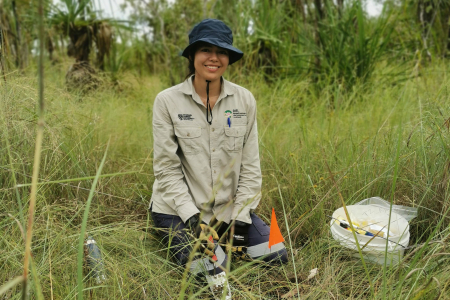News
Ants a mirror to ecosystem restoration
New research underway at Charles Darwin University (CDU) aims to develop a genetics-based technique for monitoring ants and termites as indicators for the rehabilitation of ecosystems following mining.
CDU PhD candidate Allyson Malpartida is using a method called metabarcoding of DNA samples by capturing each species’ genetic signature at former Northern Territory mine sites to analyse the health of the ecosystem, a first in the Territory.
In her research titled ‘developing a new genomics approach to using terrestrial invertebrates as bio indicators’, Ms Malpartida is looking at developing a genomics approach to using invertebrates such as ants as indicators of mine-site restoration.
She compares the ant and termite communities of disturbed ecosystems undergoing recovery with relatively intact ecosystems to measure ecosystem health.
“Healthy terrestrial invertebrates are important to a healthy ecosystem. Invertebrates like ants are very sensitive to changes in the environment, so they are good indicators of ecosystem health,” Ms Malpartida said.
“Previously, invertebrate sampling has been avoided by many researchers as the sheer number of potential species that require specialist taxonomic expertise makes identification daunting.”
“We are trialing some recently developed genetic methods to see if we can make that process less daunting and therefore ensure invertebrate sampling is more often used in ecosystem rehabilitation.”
In addition to using DNA from ant and termite samples, Ms Malpartida will also attempt to identify these insects from environmental DNA, known as eDNA, a less invasive method.
“For eDNA we are getting our DNA samples from places like the soil, or even a termite bait, which has trace DNA left behind by the insects that move through or onto those substrates,” she said.
Through field trips and sample collections at Ranger Uranium Mine inside Kakadu National Park, she hopes to help develop a method for long-term monitoring of the mine for it to be incorporated into the national park.
She is also taking samples from Nabarlek Uranium Mine, Pine Creek Gold Mine and Jabiluka mine in the Northern Territory to analyse the recovery of these rehabilitated ecosystems.
With the data collected, Ms Malpartida hopes to develop a reliable and cost-effective technique for assessing how well the ecosystem at mine sites has been restored.
“My goal is to develop a method for monitoring terrestrial invertebrate bioindicators long-term and make it more available for different companies and organisations to use the technology to assess land restoration,” she said.
“The data from DNA sequences can be stored and reanalysed years later. When more species are added to reference databases the analysis can be rerun and more can be picked up over time, which is great for regulatory monitoring.”
“The signs of invertebrates returning means some larger animals have a food source and can return to a disturbed site too. We need invertebrates to be back before everything else comes back to the land.”
The project is supervised by Professors Alan Andersen and Sam Banks at the CDU Research Institute of Environment and Livelihoods and is in partnership with the Commonwealth Government through the Supervising Scientist Branch of the Department of Agriculture, Water and the Environment.
This research project has begun sampling on the site of the former Nabarlek Uranium Mine in West Arnhem Land and involves ongoing collaboration with the traditional owners of that site.
Allyson Malpartida’s project also involves collaborations with CSIRO Land and Water and the Centre for Mined Land Rehabilitation at the University of Queensland.
Related Articles

CDU mourns passing of beloved Territorian
Charles Darwin University acknowledges passing of distinguished judge, educator and former Administrator of the Northern Territory, the Honourable Austin Asche AC KC.
Read more about CDU mourns passing of beloved Territorian
Territory a step closer to growing its own crop of architects
Fifty years after Cyclone Tracy caused devastation and destruction across the suburbs of Darwin, the Northern Territory will soon have its own crop of locally educated architects designing buildings to withstand such forces.
Read more about Territory a step closer to growing its own crop of architects
Study reveals extreme rate of Australia’s invertebrate extinction
An estimated one to three species of insects and other native invertebrates are becoming extinct in Australia every week, according to a new study revealing the immense scale of the nation’s biodiversity loss.
Read more about Study reveals extreme rate of Australia’s invertebrate extinction
